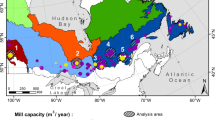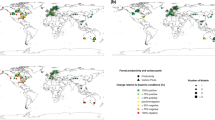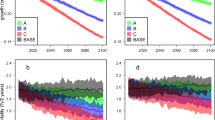Summary
The temporal response of forests to CO2-induced climate changes was examined for eastern North America. A forest stand simulation model was used with the assumption that climate will change at a constant rate as atmospheric CO2 doubles, and then as CO2 doubles again. Before being used to project future vegetation trends, the simulation model FORENA was verified by its ability to reproduce long, temporal sequences of plant community change recorded by fossil pollen and by its ability to reproduce today's vegetation. The simulated effects of changing monthly temperature and precipitation included a distinctive dieback of extant trees at most locations, with only partial recovery of biomass in areas of today's temperate deciduous forest. In the southern portion of today's deciduous-coniferous transition forests the simulated dieback was indistinct and recovery by deciduous tree species was rapid. In more northerly transition areas, the dieback not only was clearly expressed, but occurred twice, when new dominant species replaced extant conifers, then were themselves replaced, as climate change continued. Boreal conifers also underwent diebacks and were replaced by deciduous hardwoods more slowly in the north than in the south. Transient responses in species composition and carbon storage continued as much as 300 years after simulated climate changes ceased.
Similar content being viewed by others
References
Bassett JR (1964) Tree growth as affected by soil moisture availability. Soil Sci Soc Am Proc 28:436–438
Botkin DB, Janak JF, Wallis JR (1972) Some ecological consequences of a computer model of forest growth. J Ecol 60:849–872
Botkin DB, Janak JF, Wallis JR (1973) Estimating the effects of carbon fertilization on forest composition by ecosystem simulation. In: Woodwell GM, Pecan EV (eds) Carbon and the biosphere. Rept CONF-720510, At Energy Comm, NTIS, Springfield, Virginia, pp 328–344
Braun EL (1950) Deciduous Forests of Eastern North America. Hafner Press, New York
Bray JR (1956) Gap-phase replacement in a maple-basswood forest. Ecology 37:598–600
Britton NL, Brown A (1913) An illustrated flora of the northern United States and Canada, Vols 1–3. Reprinted 1970, Dover Publ Inc, New York
Curtis JT (1959) The vegetation of Wisconsin: An ordination of plant communities. Univ Wisconsin Press, Madison
Dale VH, McLaughlin SB (1984) Forest growth trends in the eastern US: Status report on empirical and modelling approaches. Tech Note 93. Univ Maine Col For Res, Orono, Maine
Diller JD, Clapper RB (1965) A progress report on attempts to bring back the chestnut tree in the eastern United States, 1954–1964. J For 63:186–188
Doyle TW (1983) Competition and growth relationships in a mixed-age, mixed species forest community. PhD Dissertation, Univ Tennessee, Knoxville, Tennessee
Edmonds JA, Reilly JM (1985) Future global energy usage and fossil fuel CO2 emissions. Chapter 9. In: Trabalka JR, (ed) Atmospheric carbon dioxide and the global carbon cycle. U.S. Dept of Energy, Washington D.C. (in press)
Emanuel WR, Shugart HH, Stevenson ML (1985) Climate change and the broad-scale distribution of terrestrial ecosystem complexes. Clim Change 7:29–43
Fowells HA (1965) Silvics of forest trees of the United States. Agr Hndbk No. 271. U.S.D.A. For Serv, Washington, D.C.
Gammon RH, Sundquist ET, Fraser PJ (1985) History of carbon dioxide in the atmosphere. Chapter 3. In: Trabalka JR (ed) Atmospheric carbon dioxide and the global carbon cycle. U.S. Dept of Energy, Washington D. C. (in press)
Green CR, Sellars WD (1964) Arizona climate. Univ Arizona Press, Tucson, Arizona
Hansen J, Russell G, Lacis A, Fung I, Rind D (1985) Climate response times: Dependence on climate sensitivity and ocean mixing. Science 229:857–859
Hare KF, Thomas MK (1979) Climate Canada, 2nd edit. John Wiley & Sons, Canada Ltd, Toronto
Harlow WM, Harrar ES, White FM (1979) Textbook of dendrology, 6th edit, McGraw Hill Book Co, New York
Houghton RA, Hobbic JE, Mellilo JM, Moore B, Peterson BJ, Shaver GR, Woodwell GM (1983) Changes in carbon content of terrestrial biota and soils between 1860 and 1980: A net release of CO2 to the atmosphere. Ecol Monogr 53:235–262
Johnson AH (1983) Red spruce decline in the northeastern US: Hypotheses regarding the role of acid rain. J Air Pollut Control Assoc 33:1049–1054
Johnson WC, Sharpe DM, DeAngelis DL, Fields DE, Olson JR (1981) Modeling seed dispersal and forest island dynamics. In: Burgess RL, Sharpe DM (eds) Forest Island Dynamics in Man-Dominated Landscapes. Springer New York, pp 215–239
Keeling CD, Carter AF, Mook WG (1984) Seasonal, latitudinal, and secular variations in the abundance and isotopic ratios of atmospheric CO2. J Geophys Res 89:4615–4628
King JE (1981) Late Quaternary vegetational history of Illinois. Ecol Monogr 51:43–62
Kramer PJ, Decker JP (1944) Relation between light intensity and rate of photosynthesis of loblolly pine and certain hardwoods. Plant Physiol 19:350–358
Kramer PJ, Sionit N (1985) Rising CO2 expected effect on tree development and what deficiencies in knowledge we need to remove. In: Shands WE (ed) Proc Conf on Rising CO2 and Changing Climate: Forest Risks and Opportunities. Conservation Foundation, Washington D.C. (in press)
Kuchler AW (1964) Potential natural vegetation of the conterminous United States. Spec Publ 36, Amer Geogr Soc, New York
LaMarche VC, Graybill DA, Fritts HC, Rose MR (1984) Increasing atmospheric carbon dioxide: Tree ring evidence for growth enhancement in natural vegetation. Science 225:1019–1021
Larcher W (1969) The effect of environmental and physiological variables on the carbon dioxide gas exchange of trees. Photosynthetica 3:167–198
Lemon ER (ed) (1983) CO2 and plants: The response of plants to rising levels of atmospheric carbon dioxide. Symp 84, Am Assoc Adv Sci. Westview Press, Boulder, Colorado
Little EL (1971) Atlas of United States Trees, Volume 1: Conifers and important hardwoods. U.S.D.A. For Serv Misc Publ 1146, Washington D.C.
Little EL (1977) Atlas of United States trees, Volume IV: Minor eastern hardwoods. U.S.D.A. For Serv Misc Publ 1342, Washington D.C.
Manabe S (1983) Carbon dioxide and climatic change. Adv Geophys 25:39–82
Manabe S, Stouffer RJ (1980) Sensitivity of a global model to an increase of CO2 in the atmosphere. J Geophys Res 85 (C10):5529–5550
Manabe S, Wetherald RT (1980) On the distribution of climate change resulting from an increase in CO2-content of the atmosphere. J Atmos Sci 37:99–118
Manabe S, Wetherald RT, Stouffer RJ (1981) Summer dryness due to an increase of atmospheric CO2-concentration. Clim Change 3:347–386
McLaughlin SB, West DC, Blasing TJ (1983a) Measuring effects of air pollution stress on forest productivity: Some perspectives, problems, and approaches. In: Proc Technical Association of the Pulp and Paper Industry. Tappi Press, Atlanta, Georgia, pp 321–333
McLaughlin SB, Blasing TJ, Mann LK, Duvick DN (1983b) Effects of acid rain and gaseous pollutants on forest productivity: A region-scale approach. J Air Pollut Contr Assoc 33:1042–1049
Mitchell JFB, (1983) The seasonal response of a general circulation model to changes in CO2 and sea temperatures. QJR Meteorol Soc 109:113–152
Mitchell JFB, Lupton G (1984) A4XCO2 integration with prescribed changes in sea surface temperatures. Prog Biometeorol 3:353–374
Monsi M, Uchijima Z, Oikawa T (1973) Structure of foliage canopies and photosynthesis. Ann Rev Ecol Syst 4:301–327
Moorhead DL (1985) Development and application of an upland boreal forest succession model. PhD Thesis Univ Tennessee. Knoxville, Tennessee
Nichols JO (1968) Oak mortality in Pennsylvania: A ten-year study. J For 66:681–694
Olson JS (1975) Productivity of forest ecosystems. In: Reichle DE, Franklin JF, Goodall DW (eds) Productivity of World Ecosystems. National Academy of Science, Washington, D.C. pp 33–43
Olson RJ, Emerson CJ, Nungesser MK (1980) Geoecology: A county-level experimental data base for the conterminous United States. Rept ORNL/TM-7351. Oak Ridge Nat Lab, Oak Ridge, Tennessee
Olson JS, Watts JA, Allison IJ (1983) Carbon in live vegetation of major world ecosystems. Rept ORNL/TM-5862, Oak Ridge Nat Lab, Oak Ridge, Tennessee
Palutikof JP, Wigley TML, Lough JM (1984) Seasonal climate scenarios for Europe and North America in a high-CO2, warmer world. Rept TR012, U.S. Dept Energy, Washington, D.C.
Pastor J, Post WM (1985) Influence of climate, soil moisture, and succession on forest carbon and nitrogen cycles. Biogeochemistry (in press)
Plochmann R (1984) Air pollution and the dying forests of Europe. Am For 90:17–21
Rowe JS (1972) Forest Regions of Canada. Canaian Forestry Service Publ 1300, Ottawa, Canada
Sakai A, Weiser CJ (1973) Freezing resistance of trees in North America with reference to tree regions. Ecology 54:118–126
Schneider SH, Thompson SL (1981) Atmospheric CO2 and climate: Importance of the transient response. J Geophys Res 86(C4):3135–3147
Shugart HH (1984) A Theory of Forest Dynamics. Springer-Verlag, New York
Shugart HH, West DC (1977) Development of an Appalachian deciduous forest succession model and its application to assessment of the impact of the chestnut blight. J Environ Manage 5:161–170
Shugart HH, West DC (1979) Size and pattern of simulated forest stands. For Sci 25:120–122
Shugart HH, Emanual WR, Solomon AM (1984) Modeling longterm changes in forested landscapes and their relation to the earth's energy balance. In: Moore B, Dastoor MN (eds) The interaction of global biogeochemical cycles. Publ No 84-21, Jet Propulsion Lab, NASA, Pasadena, California, pp 229–252
Sollins P, Reichle DE, Olson JS (1973) Organic matter budget and model for a southern Appalachian Liriodendron forest. Report EDFB/IBP-73/2, Oak Ridge Nat Lab, Oak Ridge, Tennessee
Solomon AM, Shugart HH (1984) Integrating forest-stand simulations with paleoecological records to examine long-term forest dynamics. In: Agren GI, (ed) State and change of forest ecosystems—Indicators in current research. Swed Univ Agric Sci Rept No 13, Uppsala, Sweden, pp 333–356
Solomon AM, Tharp ML (1985) Simulation experiments with late Quaternary carbon storage in mid-latitude forest communities. In: Sundquist ET, Brocker WS (eds) The carbon cycle and atmospheric CO2: Natural variations Archean to present. Geophys Monogr 32, Am Geophys Union, Washington D.C., pp 235–250
Solomon AM, Webb T III (1985) Computer-aided reconstruction of Late-Quaternary landscape dynamics. Ann Rev Ecol Syst 16:63–84
Solomon AM, West DC (1985) Simulating responses to expected climate change in eastern North America: Applications to decision-making in the forest industry. In: Shands WE (ed), Proc Conf on Rising CO2 and Changing Climate: Forest Risks and Opportunities. Conservation Foundation, Washington, D.C. (in press)
Solomon AM, Delcourt HR, West DC, Blasing TJ (1980) Testing a simulation model for reconstruction of prehistoric foreststand dynamics. Quat Res 14:275–293
Solomon AM, West DC, Solomon JA (1981) Simulating the role of climate change and species immigration in forest succession. In: West DC, Shugart HH, Botkin DB (eds), Forest Succession: Concepts and Application. Springer-Verlag, New York, pp 154–177
Solomon AM, Tharp ML, West DC, Taylor GE, Webb JM, Trimble JC (1984) Response of unmanaged forests to CO2-induced climate change: availabile information, initial tests and data requirements. Rept TR009, U.S. Dept of Energy, Washington, D.C.
Solomon AM, Trabalka JR, Reichle DE, Voorhees LD (1985) Atmospheric carbon dioxide and the global cycle of carbon. Chapter 1 In: Trabalka JR (ed) Atmospheric carbon dioxide and the global carbon cycle. U.S. Dept of Energy, Washington D.C. (in press)
Tharp ML (1978) Modeling major perturbations in a forest ecosystem. MS Thesis Univ Tennessee, Knoxville, Tennessee
Thornthwaite CW, Mather JR (1957) Instructions and tables for computing potential evapotranspiration and the water balance. Drexel Inst Publ in Climatol 10:1–181
Trabalka JR (ed) (1985) Atmospheric carbon dioxide and the global carbon cycle. U.S. Dept of Energy, Washington D.C. (in press)
Watt AS (1947) Pattern and process in the plant community. J Ecol 35:1–22
West DC, Solomon AM (1984) Forest responses to elevated levels of carbon dioxide. Bull Ecol Soc Am 65:59 (Abstract)
White PS (1979) Pattern, process, and natural disturbance in vegetation. Bot Rev 45:229–299
Whittaker RH, Likens GE (1973) Carbon in the Biota. In: Woodwell GM, Pecan EV (eds) Carbon in the biosphere. Rept CONF-720510, U.S. At Energy Comm, N.T.I.S., Springfield, Virginia, pp 303–327
Wigley TML, Jones PD, Kelly PM (1980) Scenario for a warm, high-CO2 world. Nature 283:17–21
Author information
Authors and Affiliations
Additional information
Environmental Sciences Division Publication No. 2625
Rights and permissions
About this article
Cite this article
Solomon, A.M. Transient response of forests to CO2-induced climate change: simulation modeling experiments in eastern North America. Oecologia 68, 567–579 (1986). https://doi.org/10.1007/BF00378773
Received:
Issue Date:
DOI: https://doi.org/10.1007/BF00378773




